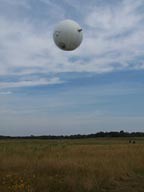Rock On for Paint On: Successful Test of “Paint On” Antenna Technology Announced
Who was it that said technology for those who do not  understand it is indistinguishable from magic?
understand it is indistinguishable from magic?
I can’t recall at the moment, but I was reminded of the quote as I read about the successful test flight of an airship utilizing new "paint-on" antenna technology.
NASA’s Langley Research Center, RTI International, Applied EM, Inc., International Communications Group, Unitech, Sierra Nevada Corporation, and Techsphere Systems International, Inc. today announced the successful June 21 completion of the test flights in Nevada.
Azom provides additional details:
The experiment provided the first opportunity to test and evaluate the electrical, electromagnetic and mechanical properties of the "paint-on" antenna technology during an actual flight.
"The successful airship test flights demonstrate exciting possibilities for ‘paint-on’ antenna technologies," said David Myers, vice president of RTI’s Engineering and Technology Unit. "This new technology can be used to assist with hurricane disaster relief, provide enhanced security of ports and borders, perform science observation missions and improve military communications."
High altitude airships can be used for both defense and homeland security purposes including surveillance of battlefields and domestic borders and ports. The airships are intended to serve as economical station-keeping communications and/or ground-sensing platforms that will augment both ground-based and more expensive satellite systems. The airships will operate well above commercial air traffic and the jet stream and beyond the range of most ground-to-air missiles.
In addition to communications, the "paint-on" antennas are a key enabling technology to achieve the high altitudes necessary for Department of Defense and Homeland Security persistent surveillance missions of the nation’s coastal waters, land borders, urban areas and critical infrastructure.
"RTI also arranged for NASA to demonstrate the potential of a lower-cost alternative to satellite remote sensing by installing a GPS Reflectance Remote Sensing Experiment to conduct soil moisture measurements during the flight," according to Azom.
Although it’s certainly a long way off, one can imagine the technology one day applied to the side of your house — eliminating the need for either a satellite dish or (for some of us) the old bunny ears.
It doesn’t even have to look like aluminum foil, apparently.
